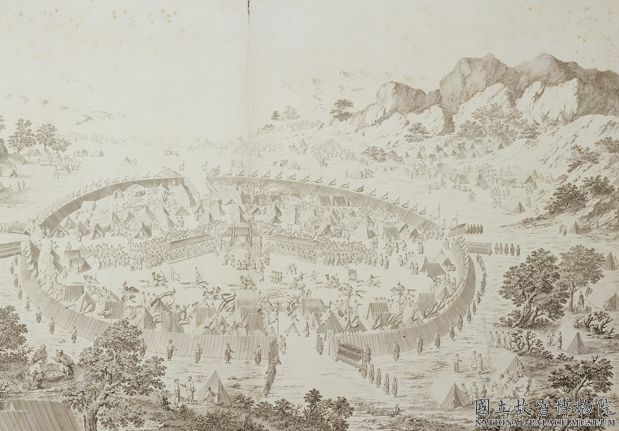[Zhao Zuo’s landscape map axis (looking at the mountain for fishing)]
“Landscape map axis” (looking at the mountain for fishing), Ming Dynasty, Zhao Zuo’s painting, paper edition, color setting, vertical 132.3 cm, horizontal 38 cm
Most of the painting styles in the late Ming Dynasty were changed from the former people’s painting methods, and most of them had obvious artistic traces of the predecessors. This is also the reflection of the trend of retro art in the painting works in the late Ming Dynasty, thus forming the distinctive characteristics of the era of the late Ming Dynasty art. Zhao Zuoshan is in this era. His works, even the Susong School paintings he represents, have this feature. It is not difficult to see this feature from the “Landscape Axis”
This picture shows the life of literati in the late Ming Dynasty. It is roughly divided into three sections: the lower part is painted near the water and soil slope, the grass house looms out from the trees, and a man in the house reads by the window; The water in the middle lake is rippling, and a man is fishing with a pole in the reeds, and the action of turning his head to look at the distant mountains shows that he is not fishing; There is a mountain peak on the upper part, which occupies a limited space and leaves a large gap. The painter wrote two poems here in neat regular script: “Fishing is meaningful, looking at how far away the mountain is”, highlighting the theme. According to the poem, later generations also named this picture “Fishing at the Mountain”. After the poem, the words “Zhao Zuo in my summer” were signed, and the two seals of “Zhao Zuo’s seal” and “Wendu’s” were affixed. According to “self”, it is the forty-seventh year of Wanli (1619) in the Ming Dynasty. As far as we know, Zhao’s latest work is the Silent Painting of Fallen Leaves in 1629, which should also belong to his later work
The painting method of the works inherits the tradition of Huang Gongwang and Ni Zan, the painters of the Yuan Dynasty. The expression method of the distant mountains is obviously influenced by Zhao Mengfu of the Yuan Dynasty. The mountains and stones are covered with hemp texture, and the form of the untwisted style is draped from the top of the mountain, with light colors, which is very primitive and elegant. The landscape adopts a combination of flat and far-reaching composition, which makes the original narrow vertical picture open, and the three-section layout method adds to the sense of secluded distance. The realistic treatment at the bottom of the picture, the description of the water surface in the middle and the performance of the distant mountains and the sky constitute a strong contrast between reality and reality; The calm and tranquil manner of the characters in the picture and the dancing motion of the trees and reeds due to the wind also form a sharp contrast between movement and stillness. Through sharp contrast, the author created a good atmosphere for the life of literati
The whole picture is mainly painted in water and ink. The ink color is clear and moist, and the intensity of dry and wet, thirst and dry are controlled properly; The colors are elegant and beautiful, and only light ochre and cyan are slightly dyed, so that the painting mask is quaint and tranquil, but not gaudy; The brushwork is free and elegant, the ink in the freehand brushwork is dripping, the fine brushwork in the neat part is like silk, and the brushwork is strong and elegant. The characters are simple in shape, not in shape, but in a few strokes, they look like, showing the author’s profound artistic skills. This picture is a masterpiece of landscape paintings created by Zhao Zuo in his later years.
![图片[1]-Zhao Zuo’s landscape map axis (mountain fishing)-China Archive](https://chinaarchive.net/Ming dynasty/painting/23824[1024].jpg)

![[Qing Dynasty] British female painter—Elizabeth Keith, using woodblock prints to record China from the late Qing Dynasty to the early Republic of China—1915-China Archive](https://chinaarchive.net/wp-content/uploads/2022/11/image-191x300.png)



